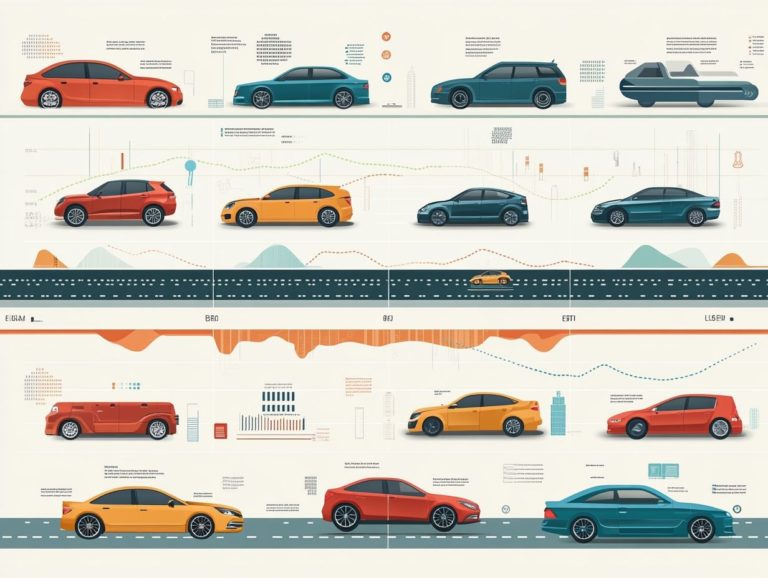Understanding Manufacturer Suggested Retail Prices
Manufacturer Suggested Retail Prices (MSRPs) are important in the pricing landscape of consumer products. They serve as a benchmark for both manufacturers and buyers.
This article explains MSRPs and why they matter to you. It examines various factors that shape these prices, including production costs, market demand, and competition.
You ll discover the advantages and disadvantages of MSRPs for both manufacturers and consumers. Plus, you ll find practical tips on how to use this information for more informed purchases.
Whether you consider yourself a savvy shopper or are intrigued by pricing strategies, this guide will equip you with valuable insights to deepen your understanding of MSRPs.
Contents
Key Takeaways:

- Manufacturer Suggested Retail Prices (MSRPs) are the recommended prices set by manufacturers for their products, serving as a benchmark for retailers and consumers.
- MSRPs are influenced by various factors such as production costs, market demand, and competition, which can affect the final price of a product.
- Understanding MSRPs can help consumers make informed purchases by knowing the price hierarchy and using comparison shopping techniques to find the best deal.
What are Manufacturer Suggested Retail Prices (MSRPs)?
Manufacturer Suggested Retail Prices (MSRPs) are essential to grasp within the automotive landscape. They serve as the recommended price for vehicles you ll find at dealerships. Set by manufacturers, these prices play a key role in shaping vehicle pricing strategies and influencing your purchasing decisions.
MSRPs offer insight into the perceived value of various vehicle features, guiding you during price negotiations. By understanding MSRPs, you can better recognize price variations and retail margins, ultimately empowering yourself in the pursuit of high-value products.
Factors That Influence MSRPs
Several factors significantly influence Manufacturer Suggested Retail Prices (MSRPs), including production costs, market demand, and competitive dynamics within the automotive sector. Each of these elements plays a crucial role in shaping the pricing strategies manufacturers and dealerships use to determine a vehicle’s sale price.
This ensures they stay competitive while accurately reflecting the vehicle’s true value. By understanding these factors, you can navigate pricing negotiations better, recognizing the components that contribute to price variations and profit margins.
Cost of Production
The cost of production is a pivotal factor in determining MSRPs, affecting how you price your products.
Elements such as raw materials, labor, and overhead expenses are critical in shaping these prices. It’s essential to scrutinize the quality of materials used; higher-quality components can elevate production costs, impacting your overall pricing structure.
Labor costs, encompassing wages and benefits, play a significant role in the final MSRP. You must strike a balance between providing fair compensation and exercising cost control. Overhead expenses, such as utilities and rent, add complexity to pricing.
To remain competitive in the market, regularly assess competitor pricing. Your goal should be to find a sweet spot that allows you to recover production costs while appealing to price-sensitive consumers, ensuring your offerings are attractive and profitable.
Market Demand

Market demand is a powerful force that shapes Manufacturer Suggested Retail Prices (MSRPs). The popularity of certain vehicle features often drives pricing strategies in the consumer market.
When consumer preferences shift perhaps fueled by a growing interest in fuel-efficient models or advanced safety features manufacturers adjust their MSRPs to stay competitive. For instance, as electric vehicles gain traction due to heightened environmental awareness, manufacturers might raise the prices of conventional models while lowering those of electric vehicles to entice buyers.
This dynamic shows how demand and specific features affect each other. As certain attributes, like state-of-the-art infotainment systems or superior fuel efficiency, come into vogue, prices adjust to reflect the competition for consumer attention. Fluctuating market demands influence not only MSRPs but also the evolution of vehicle offerings themselves.
Competition
Competition in the automotive industry is crucial for shaping Manufacturer Suggested Retail Prices (MSRPs). This compels manufacturers and dealerships to embrace dynamic pricing strategies that effectively respond to retail competition.
When consumers face a plethora of choices, even the slightest price fluctuation can sway their decisions. In this landscape, analyzing competitor pricing and adjusting MSRPs is essential. Tactics like limited-time promotions, rebates, and enticing financing offers attract cost-conscious buyers and foster brand loyalty.
Price-matching strategies help dealerships remain competitive. This heightens the pressure on manufacturers to continually refine their pricing frameworks.
The interaction among market players creates a fluid pricing environment that significantly influences consumer purchasing behavior.
Pros and Cons of MSRPs
Understanding the pros and cons of Manufacturer Suggested Retail Prices (MSRPs) is crucial for both manufacturers and consumers. These price benchmarks considerably influence retail pricing and perceived value within the automotive industry.
For manufacturers, MSRPs serve as a guiding framework that helps maintain organized dealership operations and streamline pricing strategies. For consumers, they provide a valuable reference point that can enhance price negotiation efforts.
Despite their benefits, MSRPs can also create challenges. Potential price manipulation and diminished pricing transparency can impact decision-making processes.
Advantages for Manufacturers
Setting Manufacturer Suggested Retail Prices (MSRPs) can supercharge your business! These pricing guidelines streamline dealership operations and enhance profit margins.
By implementing MSRPs, you create a consistent pricing framework. This framework aids in inventory management and ensures your products remain competitively positioned in the marketplace.
This structured approach enables you to predict revenue more accurately and allocate resources effectively. Ultimately, this strengthens your overall financial stability.
With a defined MSRP, retailers can set appealing prices for consumers, driving sales while protecting the manufacturer’s brand value. This balance cultivates a thriving business environment where profitability can flourish without compromising market share.
Impact on Consumers

The impact of Manufacturer Suggested Retail Prices (MSRPs) on you as a consumer is quite intricate. It plays a significant role in your purchasing decisions and shapes your perceptions of vehicle value in the marketplace.
By acting as a benchmark, MSRPs empower you during price negotiations. They provide a reliable reference point that instills confidence as you interact with sales professionals. This level of transparency fosters a sense of fairness in the transaction, making you feel more informed about market standards.
When you encounter discrepancies from the MSRP at various dealerships, your reactions can vary from skepticism to outright mistrust. This underscores the importance of consistent pricing.
Understanding these pricing dynamics enhances your perception of a vehicle’s value and aligns with your growing demand for straightforward, honest dealings in an increasingly competitive environment.
How to Use MSRPs to Make Informed Purchases
To make informed purchases, you need to grasp how to effectively use Manufacturer Suggested Retail Prices (MSRPs) as a reference point. This involves skillfully navigating the price levels and employing smart shopping methods.
Decoding Price Levels
Understanding the price levels is essential for you as a consumer. It allows you to place Manufacturer Suggested Retail Prices (MSRPs) within the broader context of vehicle pricing.
This hierarchy categorizes various pricing tiers, encompassing not just the MSRPs but also retail prices the figures you typically encounter at dealerships and sale prices that often appear during promotional events. For instance, a popular sedan may carry an MSRP of $30,000, yet the retail price could climb to $32,000 due to demand. Conversely, during a clearance event, that same vehicle might be available for a sale price of $28,000. This fluctuation shows how strategic pricing directly influences your purchasing decisions.
By grasping these dynamics, you empower yourself to make well-informed choices in the intricate automotive market.
Comparison Shopping Techniques
Employing effective comparison shopping techniques can significantly enhance your ability to make informed purchases, especially when it comes to navigating Manufacturer Suggested Retail Prices (MSRPs).
By mastering the art of comparing options across various retailers, you can make smarter choices that align with your budget and preferences. For instance, consider creating a spreadsheet that lists MSRPs alongside actual prices from different dealerships or online platforms. Evaluating specific vehicle features side by side can offer valuable insight into whether those price differences truly make sense.
Taking notes on promotional offers and incentives can further empower your negotiations. You might find yourself leveraging these deals to advocate for lower prices. Ultimately, a strategic approach to comparison shopping not only fosters your confidence but also sharpens your ability to negotiate effectively for the best possible deal.
Frequently Asked Questions

What are Manufacturer Suggested Retail Prices (MSRP)?
Manufacturer Suggested Retail Prices, or MSRP, are the prices set by the manufacturer as the recommended selling price for their products.
Why do manufacturers set MSRP?
Manufacturers set MSRP to guide retailers in pricing their products in the market.
Are retailers required to sell products at MSRP?
No, retailers are not required to sell products at MSRP. They have the freedom to set their own prices, which may be higher or lower than the MSRP.
What factors influence MSRP?
MSRP is influenced by various factors, such as production costs, market demand, competition, and the perceived value of the product.
Are MSRP and retail price the same?
No, MSRP and retail price are not the same. MSRP is the suggested price set by the manufacturer, while retail price is the actual selling price set by the retailer.
Can retailers offer discounts on Manufacturer’s Suggested Retail Price (MSRP)?
Yes, retailers can offer discounts on MSRP. This is a popular way to attract customers and boost sales.
Discounts can differ based on the retailer and the product. Always check for the best deals when shopping!





